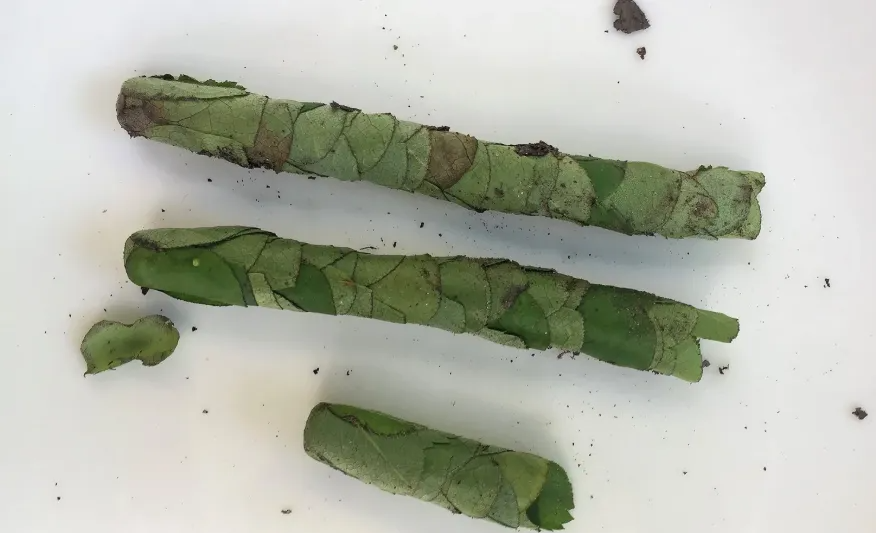你喜欢吃桃子吗?倘若咬下一口,里面不是晶莹剔透的果肉,而是一堆新鲜的碎叶子,这样奇怪的事情你遇到过吗?

图片来源于网络
这是虫害,还是桃核发芽?——别慌!你只是无意间端了某个“小可爱”的老巢。那些诡异的碎叶子,其实是切叶蜂在桃核内筑的巢。
切叶蜂是何许虫也?它其实和蜜蜂关系很近,同属蜜蜂总科,外形也与蜜蜂类似。常见的切叶蜂个头略小于普通蜜蜂,腹部背面光滑,腹面有着极易识别的金黄色毛丛。由于没有蜜蜂那样的花粉筐,它们需要将花粉贴在肚皮表面,靠毛丛的摩擦力固定住,再带回巢。
Imagine biting into a juicy peach only to discover a bundle of fresh leaf fragments instead of sweet flesh. While it might look alarming, it's not a disease or a sprouting seed — it's the hidden home of a leafcutter bee. Closely related to honeybees, these solitary insects belong to the Megachilidae family and share a similar appearance. They are slightly smaller than common honeybees, with smooth dorsal abdomens and distinctive golden hairs on their undersides, which they use to carry pollen back to their nests.
切叶蜂多为独栖性昆虫。雌蜂交配后会寻找合适的天然孔洞筑巢,如树洞、岩缝、建筑物缝隙等。有的时候,它们也不讲究——哪里有缝就往哪钻。一些小型切叶蜂甚至会将蜗牛的空壳作为巢房。

图片来源于网络
通常来说,能为花朵传粉的昆虫都深受养花人欢迎,但切叶蜂却是例外。在养花人眼里,它更像个搞破坏的“熊孩子”。
如果你在月季等蔷薇科植物的叶片上,见到边缘非常整齐、直径一两厘米的圆形缺口,那便是切叶蜂的杰作。对切叶蜂来说,画圆可不需要圆规。
Leafcutter bees live alone rather than in hives. After mating, a female searches for natural cavities such as tree hollows, rock crevices, or gaps in buildings — even abandoned snail shells — to build her nest. While most pollinators are welcome visitors to gardens, leafcutter bees have a more mischievous reputation among flower enthusiasts. Perfectly round holes in rose or other rose-family leaves are their calling card, crafted with precision that requires no compass.
切叶蜂布置巢房,其实是在为产卵做准备。雌蜂在找到合适的植物叶片后,会用强有力的上颚咬下圆形的一片,卷成卷儿抱回家。

图片来源于网络
它们会先将叶片折成“小叶杯”,塞进巢房,再外出采集花粉、花蜜,把团成小球状的蜂粮放入叶杯中,最后在蜂粮上产卵。

图片来源于网络
切叶蜂的巢房是层层卷裹而成的。它们不断地切叶杯、折叶杯,套在之前的叶杯上,持续存粮、产卵。巢房里常有十余个叶杯相套,每个杯中都有一枚卵。如果你的盆栽不幸被切叶蜂看中,多半免不了被弄得“千疮百孔”。
The intricate nest-building process is all about preparing for the next generation. A female cuts a neat circle from a leaf, rolls it, and carries it home. She shapes it into a "leaf cup" to line the nest, fills it with a pollen-and-nectar ball, and lays an egg on top. The nest grows layer by layer, with over a dozen leaf cups stacked inside, each holding a single egg. If a potted plant becomes a chosen site, its leaves will likely end up riddled with these precision-cut holes.

图片来源于网络
除了利用叶片,有的切叶蜂还会用花瓣做巢。例如一种壁蜂,为建造花瓣小屋,通常会在小洞中开始筑巢。它会从盛开的花朵上咬下花瓣,带回洞中,一层层粘合花瓣。这些花瓣的排列方式惊人地一致——都是尖端向下、切面朝上,像鳞片一样层层叠叠。

图片来源于网络
尽管切叶蜂属于蜜蜂总科中不酿蜜的类群,还会不知疲倦地“切叶”,但它们对植物造成的伤害很有限。作为重要的传粉昆虫,切叶蜂在自然生态系统中起着不可或缺的作用。
Not all leafcutter bees stick to leaves — some prefer petals. One species, a type of mason bee, bites off petals from blooming flowers and layers them like shingles to create a petal-lined nest. Despite their habit of cutting foliage, these bees cause minimal damage to plants. As vital pollinators, they play an essential role in maintaining healthy ecosystems.
所以,如果你下次在桃子里发现了切叶蜂巢穴,不必过度担忧。这只是说明桃子生长时周边生态环境较好,为切叶蜂提供了适宜的生存条件。
你遇到过什么特别的桃子吗?欢迎评论区分享。
编辑:李金昳
实习生:韩沐辰
来源:新华社 新华每日电讯微信公众号 博物 湖北日报等 |
|
 /1
/1 